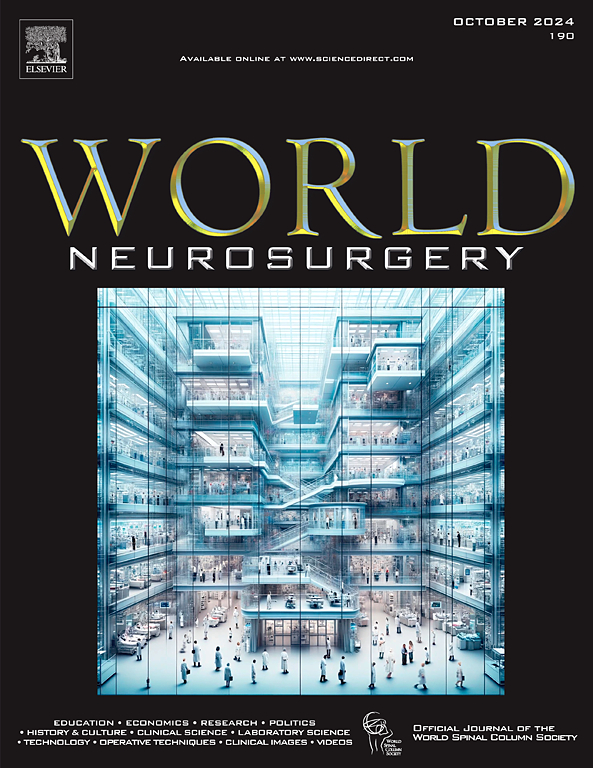Evaluation of Thoracic Paraspinal Muscles Imbalance in Adolescent Idiopathic Scoliosis with Main Thoracic Curve Based on Magnetic Resonance Imaging
IF 1.9
4区 医学
Q3 CLINICAL NEUROLOGY
引用次数: 0
Abstract
Objective
While the etiology of adolescent idiopathic scoliosis remains unclear, it is assumed that paraspinal muscle imbalance contributes to curve progression. Previous studies have found the paraspinal muscles imbalance, but no study comprehensively analyzed the roles of different paraspinal muscle layers. Our study distinguished the thoracic paraspinal muscle into superficial, intermediate, and deep layers, and analyzed the imbalance of the 3 layers.
Methods
We retrospectively included adolescent idiopathic scoliosis patients with thoracic curve. The paraspinal muscle parameters including relative muscle cross-sectional area (rmCSA) and fatty infiltration in upper end vertebra, apical vertebra, and lower end vertebra regions and in superficial, intermediate, and deep layers were calculated. The parameters between convex and concave sides were compared by paired t-test. The correlation between paraspinal muscle parameters and radiographic parameters was tested by Spearman correlation analysis.
Results
A total of 46 patients were included. In apical vertebra region, the rmCSA in superficial (P = 0.038), intermediate (P = 0.001), and deep (P = 0.001) layers on convex side was greater than that on concave side, while the fatty infiltration in intermediate (P = 0.023) and deep layers (P = 0.000) on concave side was greater than that on convex side. Radiographic parameters were associated with both intermediate ΔrmCSA (P = 0.002) and deep ΔrmCSA (P = 0.000).
Conclusions
Our research indicates that the severity of paraspinal muscle imbalance is different in three layers, with the deep layer most severe, followed by the intermediate layer, and the superficial layer least severe. The imbalance of deep muscle correlates strongly with radiographic parameters, suggesting its role as a compensatory adaptation to curve magnitude.
基于磁共振成像评价青少年特发性脊柱侧凸胸椎主曲线胸椎旁肌不平衡。
目的:虽然青少年特发性脊柱侧凸(AIS)的病因尚不清楚,但假设棘旁肌失衡有助于弯曲进展。以往的研究发现了棘旁肌的失衡,但没有研究全面分析不同层次的棘旁肌的作用。我们的研究将胸棘旁肌分为浅、中、深三层,并分析了这三层的不平衡。方法:我们回顾性地纳入有胸廓弯曲的AIS患者。计算上端椎体(UEV)、根尖椎体(AV)和下端椎体(LEV)区域以及浅层、中层和深层的棘旁肌参数,包括相对肌肉横截面积(rmCSA)和脂肪浸润(FI)。采用配对t检验比较凸侧和凹侧的参数。采用spearman相关分析检验棘旁肌参数与影像学参数的相关性。结果:共纳入46例患者。在AV区,凸侧浅层(P=0.038)、中间层(P=0.001)和深层(P=0.001)的rmCSA大于凹侧,而凹侧中间层(P=0.023)和深层(P=0.000)的FI大于凸侧。影像学参数与中间ΔrmCSA (P=0.002)和深部ΔrmCSA (P=0.000)相关。结论:我们的研究表明,椎旁肌失衡的严重程度在三层不同,深层最严重,中间层次之,浅层最轻。深层肌肉的不平衡与影像学参数密切相关,表明其对曲线大小的代偿性适应作用。
本文章由计算机程序翻译,如有差异,请以英文原文为准。
求助全文
约1分钟内获得全文
求助全文
来源期刊

World neurosurgery
CLINICAL NEUROLOGY-SURGERY
CiteScore
3.90
自引率
15.00%
发文量
1765
审稿时长
47 days
期刊介绍:
World Neurosurgery has an open access mirror journal World Neurosurgery: X, sharing the same aims and scope, editorial team, submission system and rigorous peer review.
The journal''s mission is to:
-To provide a first-class international forum and a 2-way conduit for dialogue that is relevant to neurosurgeons and providers who care for neurosurgery patients. The categories of the exchanged information include clinical and basic science, as well as global information that provide social, political, educational, economic, cultural or societal insights and knowledge that are of significance and relevance to worldwide neurosurgery patient care.
-To act as a primary intellectual catalyst for the stimulation of creativity, the creation of new knowledge, and the enhancement of quality neurosurgical care worldwide.
-To provide a forum for communication that enriches the lives of all neurosurgeons and their colleagues; and, in so doing, enriches the lives of their patients.
Topics to be addressed in World Neurosurgery include: EDUCATION, ECONOMICS, RESEARCH, POLITICS, HISTORY, CULTURE, CLINICAL SCIENCE, LABORATORY SCIENCE, TECHNOLOGY, OPERATIVE TECHNIQUES, CLINICAL IMAGES, VIDEOS
 求助内容:
求助内容: 应助结果提醒方式:
应助结果提醒方式:


